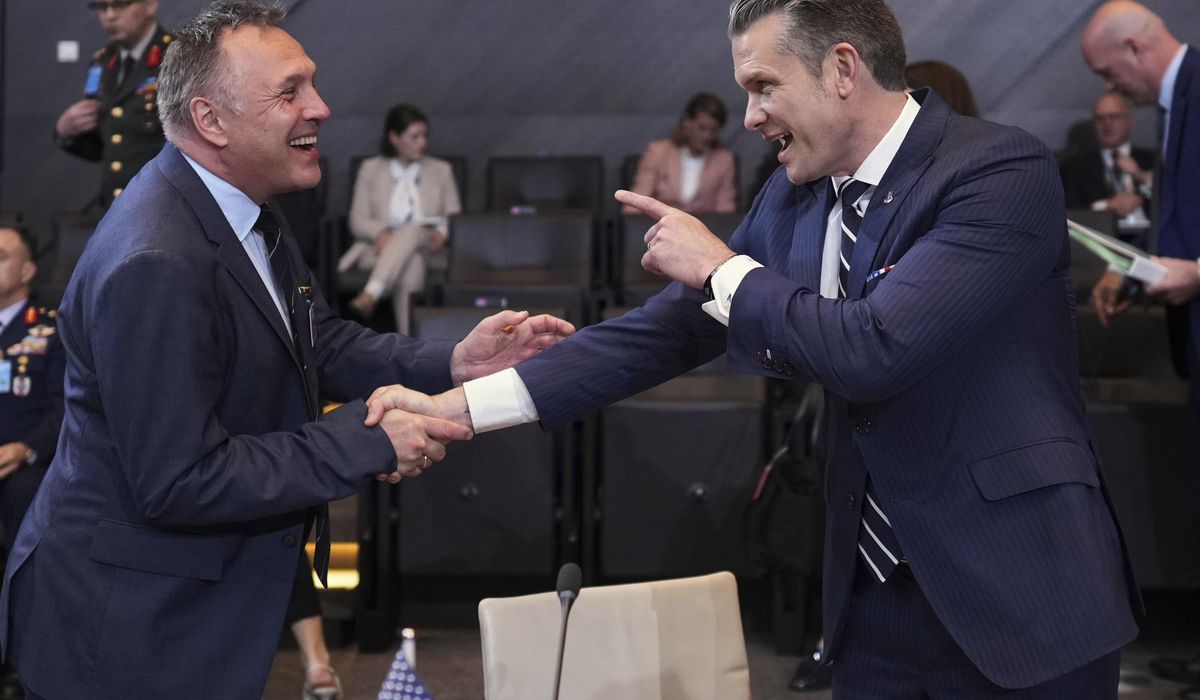


Defense Secretary Pete Hegseth said he expects NATO partners will follow President Trump’s demand that allies rapidly boost defense spending.
Speaking before a meeting of NATO defense leaders in Brussels on Thursday, Mr. Hegseth said he’s confident that alliance members would increase funding defense from 2% of gross domestic product to 5%.
“We’re here to continue the work that President Trump started, which is a commitment to 5% defense spending across this alliance, which we think will happen,” Mr. Hegseth said. “To be an alliance, you got to be more than flags. You got to be formations. You got to be more than conferences.”
Mr. Hegseth added that alliance members should commit to the spending increase before the June 24 NATO summit at The Hague.
Mr. Trump has long maintained that NATO has taken the U.S. for granted. He has ramped up his demand that member nations invest in their security.
Some leaders have risen to the challenge, pointing to Russia’s war in Ukraine as evidence for increased defense spending. However, nearly all NATO members agree that meeting the 5% level will take years.
NATO Secretary-General Mark Rutte has proposed a more diversified investment plan for some NATO nations. That would see countries spend 3.5% of GDP on defense while allocating 1.5% for infrastructure and cybersecurity.
Mr. Rutte predicts that NATO nations could meet the 5% defense spending target by 2032, a timeframe deemed too slow by some countries closer to Russia. Notably, Sweden and Estonia have proposed a five-year goal, meeting the spending target by the end of the decade.
“There’s broad support,” Mr. Rutte told reporters Thursday after chairing a meeting of NATO defense ministers at the alliance’s Brussels headquarters. “We are really close,” he said, and added that he has “total confidence that we will get there” by the next NATO summit in three weeks.
Germany has made notable moves toward improving its military footprint this year, including deploying nearly 5,000 troops in Lithuania. Newly minted German Chancellor Friedrich Merz has already promised to meet Mr. Trump’s spending demand and to field Europe’s largest conventional army.
“This is appropriate for Europe’s most populous and economically powerful country. Our friends and partners also expect this from us,” Mr. Merz said last month. “Indeed, they practically demand it.”
The United States spends by far more than any other ally in dollar terms.
But according to NATO’s most recent figures, it was estimated to have spent 3.19% of GDP in 2024, down from 3.68% a decade ago. It’s the only ally whose spending has dropped since 2014.
While the two new figures do add up to 5%, factoring in improvements to civilian infrastructure so that armies can deploy more quickly significantly changes the basis on which NATO traditionally calculates defense spending.
The seven-year time frame is also short by the alliance’s usual standards. The far more modest 2% target — set after Russia annexed Ukraine’s Crimean Peninsula in 2014 — was meant to be reached over a decade.
During Thursday’s meeting, Mr. Hegseth and his defense counterparts also approved purchasing targets for stocking up on weapons and military equipment to better defend Europe, the Arctic and the North Atlantic, as part of the U.S. push to ramp up security spending.
• This article is based in part on wire service reports.
• Vaughn Cockayne can be reached at vcockayne@washingtontimes.com.
